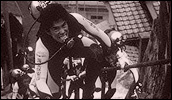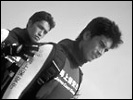Umizaru
- Year
- 2004
- Original title
- Umizaru
- Japanese title
- 海猿
- Director
- Cast
- Running time
- 120 minutes
- Published
- 1 November 2004



by Nicholas Rucka
Director Eiichiro Hasumi's Umizaru has been touted as the Japanese version of Top Gun, using emergency rescue divers in exchange for pilots. Packing in the Japanese audiences who thirsted for a cool homegrown summer blockbuster it does indeed have similarities to that 1980s Hollywood Air Force recruitment flick via ostentatious camera and dolly moves, long lens shots, and a general slick visual palette. But there is one important distinction that separates Umizaru from its counterpart: it isn't jingoistic.
The plot is a simple affair about 14 young men who want to be a part of the Japanese Coast Guard's elite team of salvage and rescue divers. This work is dangerous, most certainly involves exhuming the dead from sunken ships, and is relatively unknown - if not totally unappreciated - by the general public. The film charts the young men's brutal 50-day training period run by the strict and haunted veteran diver Minamoto (Tatsuya Fuji). As part of the training, all of the 14 young men are paired with a 'buddy' during training and are responsible for each other, at all times.
The film therefore shows, in detail, the rigors of diver's training. But rather than focus on the group as a general character the film hones in on our 'hero' Senzaki (Hideaki Ito) his buddy Kudo (Atsushi Ito) and his nemesis Mishima (Kaito). While not a bad guy, Mishima is a cold realist who is not afraid to abandon his 'buddy' if the situation demands it. Senzaki, on the other hand, is perhaps too empathetic and even though he is clearly the 'golden recruit' he has insecurities that prove problematic. Minamoto recognizes this and as a result pairs Senzaki with the woefully under qualified - to the point of being a liability - Kudo, with the aim of making Senzaki stronger and more decisive while helping Kudo maximize his potential.
But the other recruits don't get this and find it boggling that Senzaki doesn't demand a new 'buddy.' Kudo, meanwhile, is aware of his own limitations and in an emotional fit tells Senzaki and the other recruits that he became a rescue diver to save hard-working fishermen like his father and brother from accidents. For Senzaki and the others this revelation is inspiring and they vow to help Kudo succeed - Mishima, however, does not share their enthusiasm.
When Kudo drowns while trying to solo-rescue a drowning man, Mishima feels vindicated and Senzaki becomes psychologically tormented. For their leader, Minamoto, the accident scrapes away the scab covering his past and is a reminder that death shadows their every move. The incident becomes a wake-up call to the recruits and it seems that playtime is truly over. By this point we know that the ending will require the recruits to either rise to the cause or - there is no in-between. But in these types of films, we already know how the story has to resolve itself.
Umizaru is a self-actualization film. It is about overcoming obstacles, both mental and physical; it's about personal volition and why one chooses to do what they do. It is most certainly a 'feel good' movie in the same way that Hoosiers and Field of Dreams are and, as a result, is replete with their clichés. But outside of these shortcomings the film works because it doesn't pander.
While there are some poor directing choices in the film - some of these are most assuredly the result of different cultural perceptions, but not all - the directing is universally fairly strong. Seeing as director Hasumi worked as assistant director on the Japanese box-office smashes Bayside Shakedown 1 and 2, and even directed the second unit crew for part 2, it's clear that he learned well from these clever and entertaining big-budget romps. That being said, the decision to use Journey's rock ballad Open Arms as the 'love' theme for the movie is a poor one. But it's hard to be critical of its sincerity: obviously the director, writer, and producers felt it was the 'right' choice as evidenced by their singling it out for mention in the film's press kit. The employment of Open Arms, according to the director, was nostalgic and designed to evoke a summer high-school romance. In fact, the screenwriter is purported to have listened to the song repeatedly while writing the script.
Fair enough. I, however, can't be nearly as forgiving of the excessive use of dolly moves in the film. While it is a stylistic choice for the filmmakers, it becomes distracting and more pointedly dilutes the punctuating power that the dolly move can serve in visual storytelling.
Additionally, a few other small, but equally heavy-handed gestures slightly dull what is otherwise a harmless 'popcorn movie.' The flashbacks to Minamoto's life-altering diving accident, where he had to literally let go of his drowning buddy's hand in order to save himself somehow rings false. Then the decision to show Minamoto rubbing his hand while remembering this event is inept. But in a film of this type - style-over-substance - the employment of such gestures to signal emotion is meant to eradicate any doubt in interpretation for the audience: your brain is not needed to enjoy this film.
But in an example of how ultimately sensibilities really are different in between Japanese and American blockbusters - and why this film is a little deeper - we need to look at the end of the film. In a requisite manner the hero saves his nemesis, but rather than have a truly generic emotional moment on the helicopter while flying away to safety, which in Hollywood would go something like this:
NEMESIS: "I guess I should thank you..."
HERO: "What for?"
N: "For saving my skin back there."
H: "You would've done the same."
Etc.
In Umizaru, during this scene, the nemesis and hero don't talk. Mishima looks at Senzaki for a moment before Senzaki nods in understanding. Something clearly passes between them and no words need to be exchanged for the audience to understand the emotion of the moment. Even in a blockbuster of this kind there's something more subtle and human about it. Ultimately, that's what makes this film different from Top Gun.